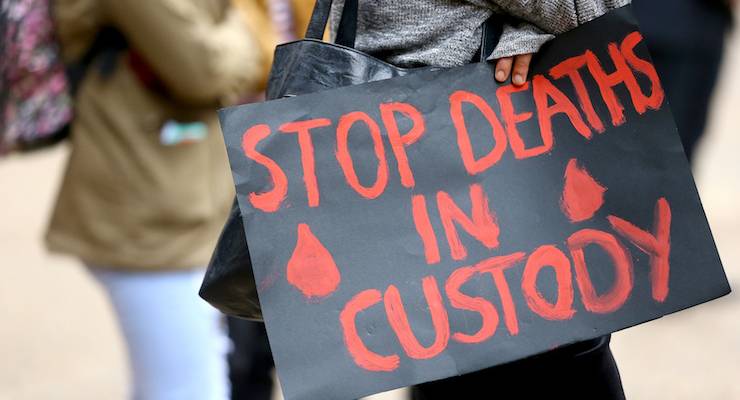
Today marks the 30-year anniversary of the landmark royal commission report into Aboriginal deaths in custody — and 30 years of failure to end the crisis.
Since the commission, more than 474 Aboriginal and Torres Strait Islander people have died while in police care, including four in March and one so far in April. Their deaths now equal more than half of Australia’s COVID-19 death toll, which sits at 910.
A national shame
Australia’s prison system is dire. Aboriginal and Torres Strait Islander people are massively over-represented in prison populations, making up 27% of the national prison population despite being only about 3.3% of the general population.
The government has also not responded to the Australian Law Reform Commission’s Pathways to Justice report tabled in 2018, which recommended reinvesting criminal justice resources into community-led initiatives to address the drivers of crime and incarceration.
The federal government also has no consolidated data on how many Aboriginal and Torres Strait Islander people have died in custody, despite the fact deaths in custody must be investigated by state coroners.
Australia’s age of criminal responsibility is 10, well below the United Nation’s recommended age of 14. It’s a law that disproportionately affects Indigenous children. A new report, tabled in Parliament this week, also found inmates in NSW prisons are prematurely ageing up to 15 years faster than the rest of the state population.
This lack of progress has led to sustained criticism from the United Nations.
Exaggerating efficacy
The 1991 royal commission report contained 339 recommendations aimed at preventing and addressing Aboriginal deaths in custody.
These recommendations ranged from getting families involved in every stage of an inquest into a family member’s death, to reducing criminalisation — with arrest being used as a last resort — and community-led responses to address social and health problems caused by alcohol use.
Assistant Minister to the Attorney-General Amanda Stoker recently said 91% of the commission’s recommendations have been fully implemented, though experts dispute the efficacy of their response. In 2019, 33 experts wrote a joint statement criticising the review of the implementation of the recommendations, arguing it misrepresents governments’ responses and has the potential to misinform policy and practice responses to Aboriginal deaths in custody.
The introduction of “paperless arrests” in the Northern Territory has led to more arrests without charge among Aboriginal people. Rates of Indigenous youth incarceration have also increased.
Cashless debit card trial data was used to argue Aboriginal people had self-determination in addressing alcohol abuse — despite the fact these trials weren’t community-led and caused issues for people to meet their basic purchasing needs.
The federal government also previously promised to fund a lifesaving custody notification service operated by Aboriginal legal service lawyers who are able to perform welfare and health checks and offer advice on those taken into custody. On Wednesday, Minister for Indigenous Australians Ken Wyatt said the federal government would contribute $2.4 million over three years to establish a mandatory custody notification scheme in South Australia. Labor has also pledged $90 million to reduce Indigenous incarceration and deaths in custody.
Deaths in 2021
Perth, WA: On April 3, a 45-year-old man died at Fiona Stanley Hospital after undergoing a medical procedure. He was an inmate at Perth’s Casuarina Prison.
Broken Hill, NSW: On March 18, 37-year-old Anzac Sullivan died from a medical episode during a police chase in Broken Hill.
Ravenhall, Victoria: On March 7, a man died in Victoria’s Ravenhall Correctional Centre.
Silverwater, NSW: Also on March 7, a woman in her mid-50s died at Silverwater Women’s Prison. It’s believed she took her own life.
Long Bay, NSW: On March 2, a man in his mid-30s died at Long Bay Hospital which is attached to Long Bay Correctional Complex in Malabar.








I am awaiting some honest reporting on this subject with disclosure of comparative statistics for non-indigenous deaths in custody on a comparable per capita basis. The first finding of the 1991 Royal Commission was that there were many more non-indigenous deaths and I believe that is still the case.
Yes, there is a lower rate of indigenous deaths. Everyone seems to want to draw the situation as similar to the US one of police brutality, whereas the real problem is that aborigines are vastly over-represented in custody in the first place, and that is where a solution should be sought.
Police brutality is a REAL problem too. Please dont discount this. Talk to any Aboriginal person who has been arrested & you will find plenty who have been bashed badly by the police. Also some who died under VERY suspicious circumstances that we all know was murder. Until Australians wake up & address this systematic racism things will not change.
Racism in Australia is a HUGE problem & is the reason for so much of the injustice Aboriginal people face on a DAILY basis.
Aboriginal people are OVERREPRESENTED in jail, jailed for petty crimes that white people get smacks on the wrist for. Educate yourself. Ignorance is no excuse.
Did you hear they’ve released a series of edited classics for the uneducated? My fave is Awaiting for Godot
Deaths in custody are due mainly to medical events not to the custodians doing the damage- whilst the non-indigenous health has improved the indigenous health has barely improved.Thus the proportion of indigenous dying is increasing as a raw percentage.
Not because of the lack of money thrown at the problem and doubling the money won’t improve matters.
So the problem lies in the lack of indigenous acceptance the health system and they themselves improving their cultural acceptance at improvement – in all spheres
Money is not the problem it is the indigenous cultural inertia at not utilising the available resources.
The HIGH rate of incarceration- for PETTY crimes like unpaid fines, or being Aboriginal & drunk on a train (its ok to be white & drunk any where through) is the reason for the high rate of deaths. The high rate of incarceration is the result of a racist police force, a racist court system & racist members of the public like you.
It begins with kids. White kids will get a slap on the wrist while Aboriginal kids end up in youth detention facilities. IGNORANT members of the public who know nothing about these issues should educate themselves before commenting.